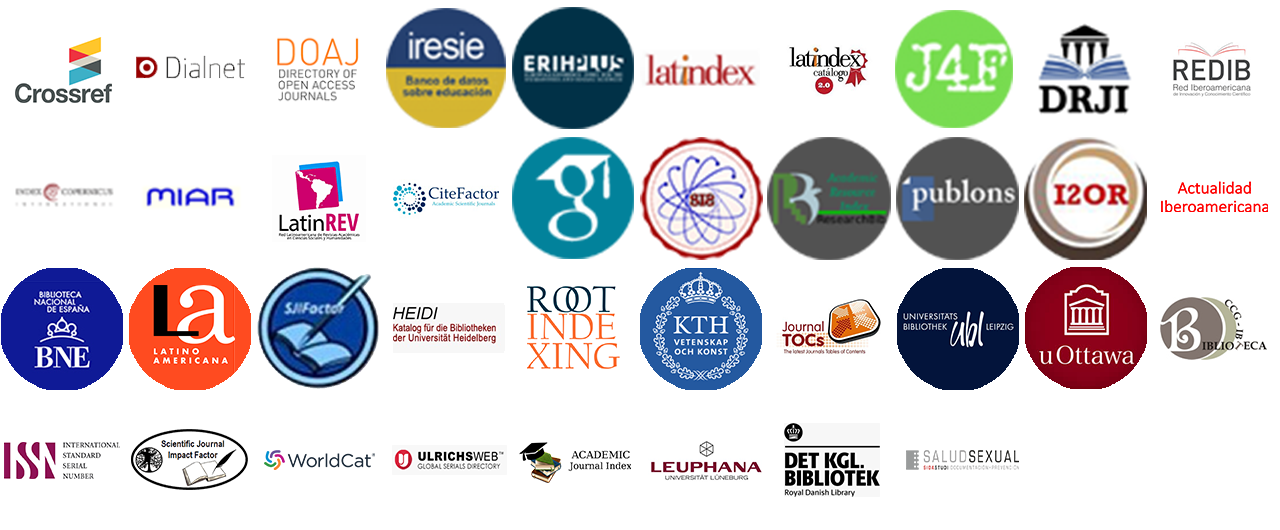Classification algorithms for detecting obesity in teenagers: A comparative study between KNN and decision trees
DOI:
https://doi.org/10.36825/RITI.11.23.007Keywords:
K nearest neighbors, Decision trees, Obesity in adolescentsAbstract
Machine learning is a branch of artificial intelligence that focuses on developing statistical algorithms and models for computer systems to learn and improve their performance from data. Classification algorithms are a type of machine learning model used to predict the class or category of an object based on observed features or attributes. In obesity classification, these algorithms have been used to develop models that predict whether an individual has obesity based on data such as body mass index, age, gender, and other risk factors. This can help identify obesity early and implement more effective preventive and treatment interventions. This article compares the effectiveness of two algorithms in predicting obesity in adolescents using a dataset of 200 participants aged 15 to 19 and four variables (weight, age, height, and gender). The decision tree and k-nearest neighbor algorithms are compared, and it is concluded that both are effective in the classification of obesity in adolescents, although decision trees are a more accurate option.
References
Organización Panamericana de la Salud. (2023). Prevención de la Obesidad. Paho. https://www.paho.org/es/temas/prevencion-obesidad#:~:text=Si%20se%20examina%20%C3%BAnicamente%20la,31%25%20de%20las%20mujeres).
Morales Márquez, L. E., Carrillo Ruiz, M., García Juárez, P., Colmenares Guillén, L. E. (2022). Determinación del riesgo de diabetes en México mediante un sistema difuso optimizado por recocido simulado. Revista de Investigación en Tecnologías de la Información, 10 (20), 130–144. https://doi.org/10.36825/RITI.10.20.011
Pérez-de-Celis Herrero, C., Lara Muñoz, C., Somodevilla García, M. J., Pineda Torres, I. H., Colmenares Guillen, E. (2016). Estilo de Vida de los Estudiantes de Informática. Revista de Investigación en Tecnologías de la Información, 4 (8), 7–13. https://doi.org/10.36825/RITI.04.08.002
Cardel, M. I., Atkinson, M. A., Taveras, E. M., Holm, J. C., Kelly, A.S. (2020). Tratamiento de la obesidad entre adolescentes: una revisión de la evidencia actual y las direcciones futuras. JAMA Pediatrics, 174 (6), 609–617. https://doi.org/10.1001/jamapediatrics.2020.0085
Instituto Nacional de Salud Pública. (2022). Encuesta Nacional de Salud y Nutrición 2021 sobre COVID-19. https://www.insp.mx/resources/images/stories/2022/docs/220804_Ensa21_digital_4ago.pdf
Alpaydin, E. (2019). Introduction to machine learning (3rd ed.). MIT Press
Delgado Huacallo, R. E., Ilachoque Hanccoccallo, C., Luque Sanabria, F., Paniura Huamani, J. M. (2022). Predicción del nivel de obesidad en personas usando el modelo de árbol de decisión. Revista Innovación y Software. https://n2t.net/ark:/42411/s9/a71
Becerra Romero, N. E., Huayna Dueñas, A. M. (2022). Aplicación Web Basado en Minería de Datos usando la Técnica de Naive Bayes para la Predicción de la obesidad en edad infantil en los Hospitales Públicos de Lima. Revista de investigación de Sistemas e Informática, 14 (2), 89–98. https://doi.org/10.15381/risi.v14i2.23150
Alva R, Lisset, Laria M, Julio, Ibarra M, Salvador, Castán R, José, Terán V, Jesús. (2020). Propuesta de un modelo difuso para determinar sobrepeso y obesidad en niños y adolescentes. Revista chilena de nutrición, 47 (4), 545-551. https://dx.doi.org/10.4067/S0717-75182020000400545
Arenas Rodríguez, A., Torres Naira, C., Vizcarra Huyhua, F. de, Sulla Torres, J., Méndez Cornejo, J. (2016). Comparación de algoritmos evolutivos para la optimización en la clasificación de la obesidad en escolares. UCMaule, (51), 25-42. https://revistaucmaule.ucm.cl/article/view/15
IBM. (2023). What is the k-nearest neighbors algorithm? https://www.ibm.com/topics/knn
Cheng, X., Lin, S. Y., Liu, J., Liu, S., Zhang, J., Nie, P., Fuemmeler, B. F., Wang, Y., Xue, H. (2021). Does physical activity predict obesity—a machine learning and statistical method-based analysis. International Journal of environmental research and public Health, 18 (8), 1-11. https://doi.org/10.3390/ijerph18083966
MathWorks. (2014). knnclassification.m. Archivo de software. https://la.mathworks.com/matlabcentral/fileexchange/47033-knnclassification-m
Breiman, L., Friedman, J. H., Olshen, R. A., Stone, C. J. (1984). Classification and Regression Trees. Routledge.
Origel-Rivas, C. G., Lara, E. R., Barrera, I. A., Alejo-Eleuterio, R. (2020). Redes neuronales artificiales y árboles de decisión para la clasificación con datos categóricos. Research in Computing Science., 149 (8), 541-554. https://rcs.cic.ipn.mx/rcs/2020_149_8/Redes%20neuronales%20artificiales%20y%20arboles%20de%20decision%20para%20la%20clasificacion%20con%20datos%20categoricos.pdf
Santiago Bazan, F., Mallqui Meza, H., Rios Recra, R. (2021). Mapeo de la cobertura vegetal en la subcuenca Quillcay (Ancash–Perú) con el clasificador de Árbol de decisiones. Aporte Santiaguino, 14 (1), 78-91. https://doi.org/10.32911/as.2021.v14.n1.761
MathWorks. (2023.). fitctree (MATLAB). https://la.mathworks.com/help/stats/fitctree.html?s_tid=srchtitle_fitctree_1
Arenas Rodríguez, A. C., Torres Naira, C. A., Vizcarra Huyhua, F. M., Sulla-Torres, J., Méndez-Cornejo, J. (2016). Comparación de algoritmos evolutivos para la optimización en la clasificación de la obesidad en escolares. Revista Académica UCMaule, (51), 25-42. https://revistaucmaule.ucm.cl/article/view/15
Grecco Dos Santos, R.R., Carra Forte, G., Mundstock, E., Azambuja Amaral, M., Gomes da Silveira, C., Chaves Amantéa, F., Frota Variani, J., Booij, L., Mattiello, R. (2020). Body composition parameters can better predict body size dissatisfaction than body mass index in children and adolescents. Eat Weight Disord, 25, 1197–1203. https://doi.org/10.1007/s40519-019-00750-4
Downloads
Published
How to Cite
Issue
Section
License
Copyright (c) 2023 Revista de Investigación en Tecnologías de la Información

This work is licensed under a Creative Commons Attribution-NonCommercial 4.0 International License.
Esta revista proporciona un acceso abierto a su contenido, basado en el principio de que ofrecer al público un acceso libre a las investigaciones ayuda a un mayor intercambio global del conocimiento.
El texto publicado en la Revista de Investigación en Tecnologías de la Información (RITI) se distribuye bajo la licencia Creative Commons (CC BY-NC
 ), que permite a terceros utilizar lo publicado citando a los autores del trabajo y a RITI, pero sin hacer uso del material con propósitos comerciales.
), que permite a terceros utilizar lo publicado citando a los autores del trabajo y a RITI, pero sin hacer uso del material con propósitos comerciales.



